Wondering how to set it up? Form tracking in WordPress?
Forms help you connect with your audience so your users can contact you and give you feedback. They also act as lead magnets and ensure you get more subscribers.
Tracking forms allows you to better understand your audience, thereby improving engagement and conversions.
In this article we will look at the best course of action WordPress form tracking with Google Analytics 4. We accompany you step by step so that you can do it yourself without expert help.
Importance of Form Tracking
As mentioned earlier, forms act as a user-friendly communication tool between you and your users. You can create contact forms, testimonial forms, registration forms, and more to conveniently request user information.
This makes forms a great way to learn more about your audience or collect data without seeming pushy or intrusive.
You can use the information you collect to improve your services and better serve your audience.
You can also use forms as lead magnets to grow your audience. Depending on how you set them up, forms can help you segment your audience so you can deliver the right message to the right inbox.
Additionally, forms also provide secure transaction portals that allow users to pay for your services directly.
On the other hand, forms offer your users a convenient way to get in touch with you without having to search for emails or contact details or use different platforms. You can also book appointments and register for events directly on your WordPress website.
As you can see, there are many ways to use forms in WordPress. This makes them a very important asset on your website. Therefore, it is important to track various aspects of this asset.
As an administrator, form tracking can help you gain insight into:
- Submissions: You can see how many people have filled out and submitted your form.
- Most Viewed: Analysis allows you to check which forms were viewed most often. You can then compare this to the number of form submitters to get a better picture of form conversions.
- Abandoned forms: With GA4 you don’t have to do any calculations. This way you can quickly see how many people have abandoned the form.
- Track events: Monitor when users click on specific fields. This can help identify which areas are getting the most attention.
Navigation paths: You can analyze the sequence of user actions before and after form interactions. This can help you understand the context in which forms are used.
Drop-off points: Identify the exact points at which users abandon the form process, enabling targeted improvements.
Now let’s take a look at the steps involved in WordPress form tracking.
Steps to Track Forms in WordPress
As you can see, you can retrieve a variety of data through WordPress forms. However, setting up form tracking in GA4 can be challenging.
You can set it up manually in Google Analytics 4 using Google Tag Manager. You can also add a tracking code to your theme or fuction.php file.
All of these methods require a certain level of programming experience, which can make them difficult to use. Even if you have the necessary experience and knowledge, it can be time-consuming, or a small mistake can cause your website to break.
For this reason, we strongly recommend you use it MonsterInsights for form tracking.

MonsterInsights is the best WordPress Google Analytics 4 plugin. You can connect it to Google Analytics without touching any code or Google Tag Manager, making it convenient for beginners and small businesses.
It simplifies Google Analytics data into user-friendly data that you can easily understand. With MonsterInsights, the analytics data is displayed in WordPress, so you don’t have to switch back and forth between different platforms.
This analytics plugin allows you to customize the data you want, so you can quickly get the information that matters most to you. This can also help you track your SEO and marketing campaigns to see if they are successful.
MonsterInsights isn’t just designed for form tracking; It can also track:
- Outbound links
- Affiliate links
- Video and media files
- E-commerce traffic
- File Downloads
- Page views
- And more…
Check out the latest MonsterInsights review here to know more about this Google Analytics plugin.
Now that you know more about MonsterInsights, let’s look at how you can use it to track forms in WordPress.
Step 1: Install and set up MonsterInsights
Before installing MonsterInsights, you should already have a GA-4 account set up.
But don’t worry. Creating a Google Analytics account is straightforward. In fact, you use your Gmail account to create an account and GA4 walks you through the process.
All you have to do is visit them Google Analytics website and select Get started today to get the ball rolling.
If you need help with this, check out this article on setting up Google Analytics 4 in WordPress.

With this in mind, we would also like to point out that MonsterInsights offers a free premium version of the plugin.
MonsterInsights Lite helps you track basic metrics on your WordPress site. However, if you want to do form tracking with MonsterInsights, you’ll need one Pro plan or higher.
First, visit the official MonsterInsights website and sign up for a plan.
Once you’ve paid for the package that best suits your needs, go to your MonsterInsights dashboard and select the Downloads tab.
Download the MonsterInsights plugin ZIP file to your PC here. While you are on this page, also copy the license key as you will need it later to activate MonsterInsights Pro.
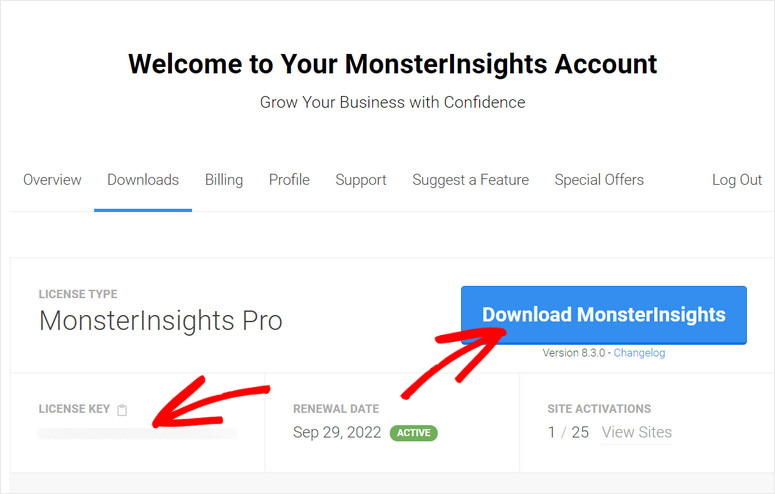
Next, go to your WordPress dashboard and select Plugins » Add new plugin. Then upload the MonsterInsights zip file and activate it like any other plugin.
If you encounter difficulties, read this article on installing plugins for help.
Now that MonsterInsights is installed and activated, go to Insights » Setup Checklist. Here are detailed step-by-step instructions for setting up MonsterInsights.
Next, expand and select “Step 1: Set up MonsterInsights.” Start wizard. This setup wizard helps you set up and customize MonsterInsights features using toggle buttons and checkboxes.
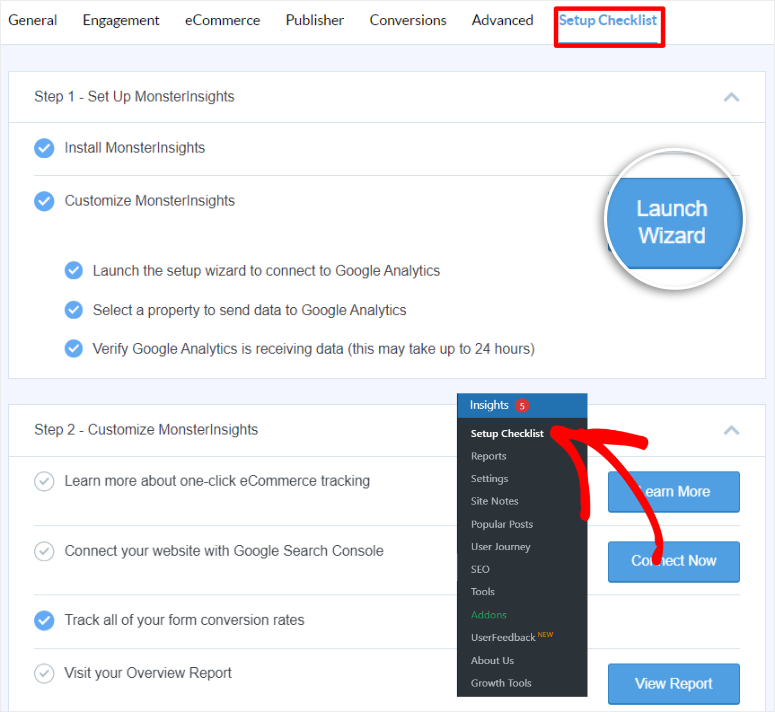
This makes configuring MonsterInsights using the wizard easier and ensures you don’t forget anything. All you have to do is follow the pages provided.
On the first page of the setup wizard, use a checkbox to tell MonsterInsights whether your WordPress site is a business website, a blog, or an eCommerce store.
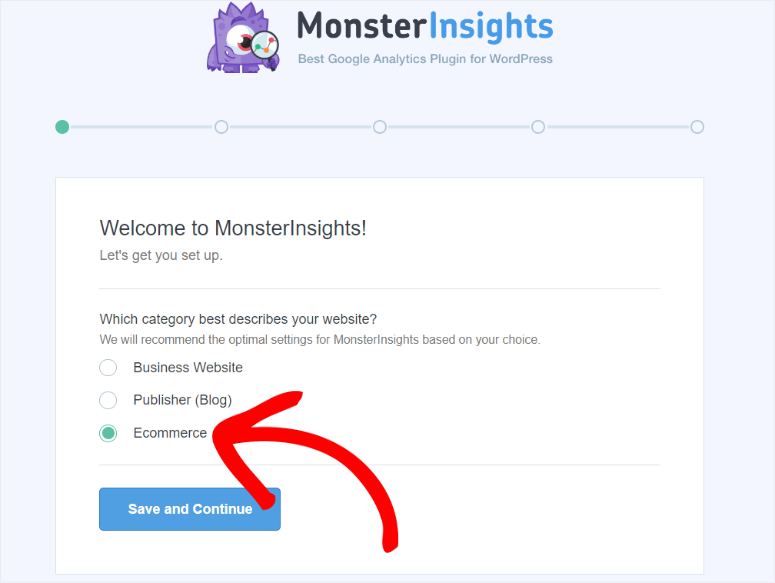
On the next page, enter the license key you copied earlier and click Connect MonsterInsights to activate the Pro version of the plugin.
Then select “Connect MonsterInsights” so you can integrate WordPress with Google Analytics using MonsterInsights.
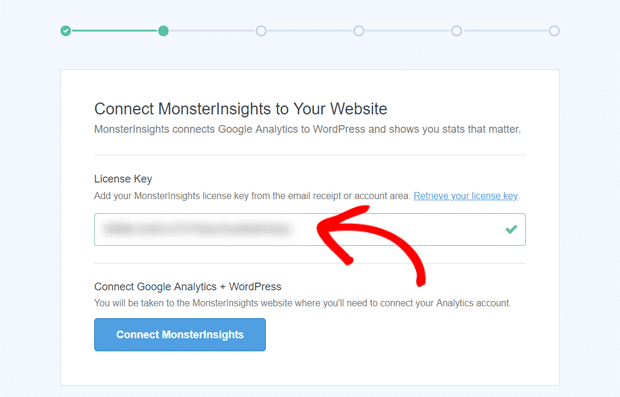
Then sign in with the Gmail account you used to sign up for Google Analytics 4. You then grant permissions to MonsterInsights.
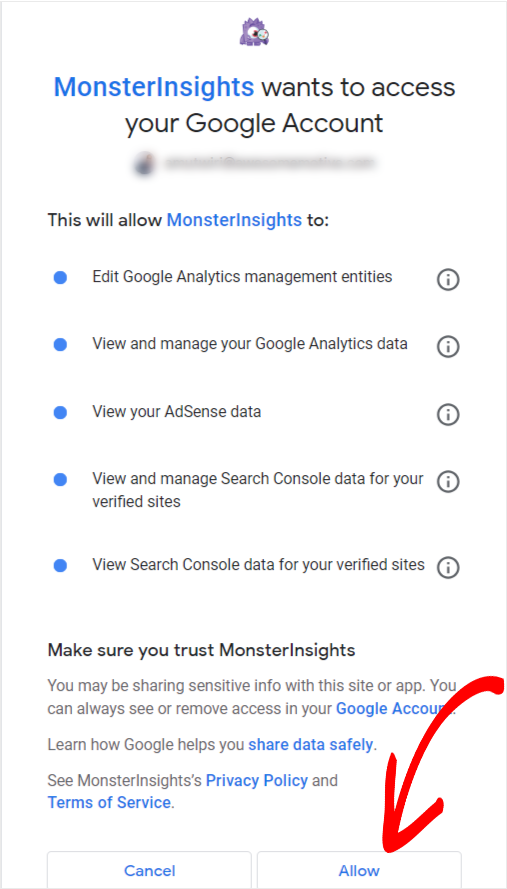
Then select the property you want to see form reports for and select “Complete Connection.”
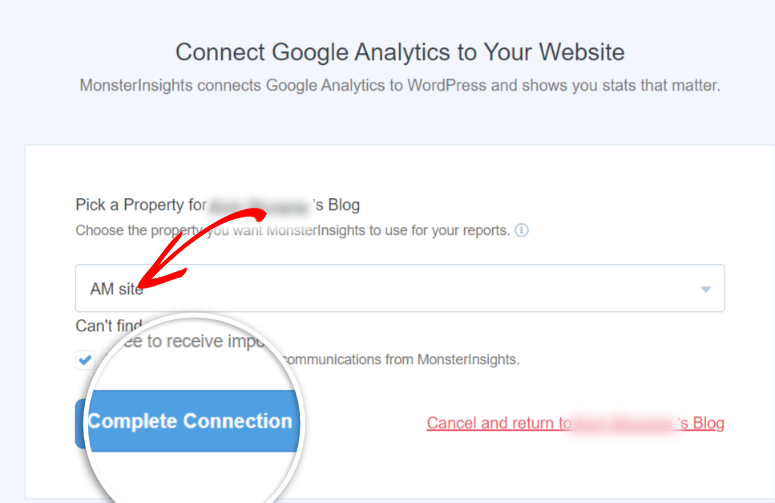
On the next page of the wizard, use the toggle keys to enable event tracking and advanced link mapping. Below that you can add which file downloads you want to track apart from the default file formats already set by this metrics plugin.
This can be especially valuable if you want to use your forms as lead magnets.
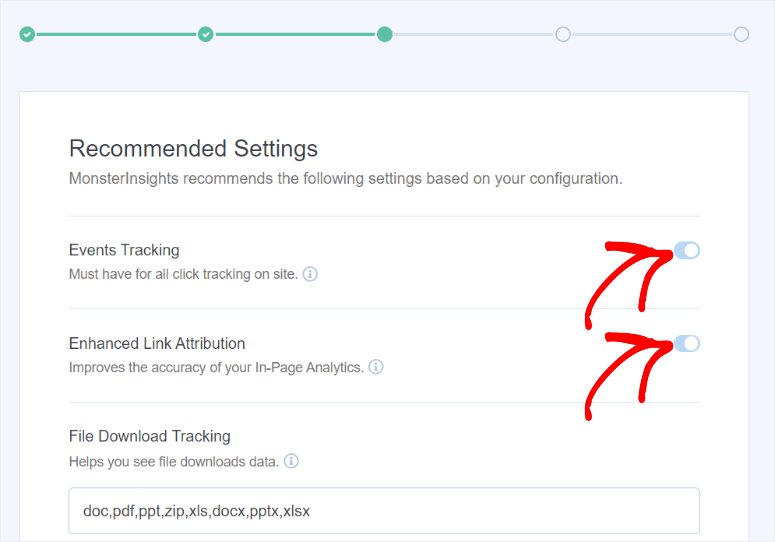
Then on the next screen, use the checkboxes to enable even more MonsterInsights features. Each checkbox has a brief explanation to ensure you understand what you are checking.
On this screen, make sure you enable “20+ Advanced Tracking.” This is the feature that enables form tracking with GA-4.
We also recommend that you enable “Advanced Reports” so you can do things like search keywords, real-time metrics, eCommerce reports, custom dimensions, and more.
This allows you to better customize your form data.
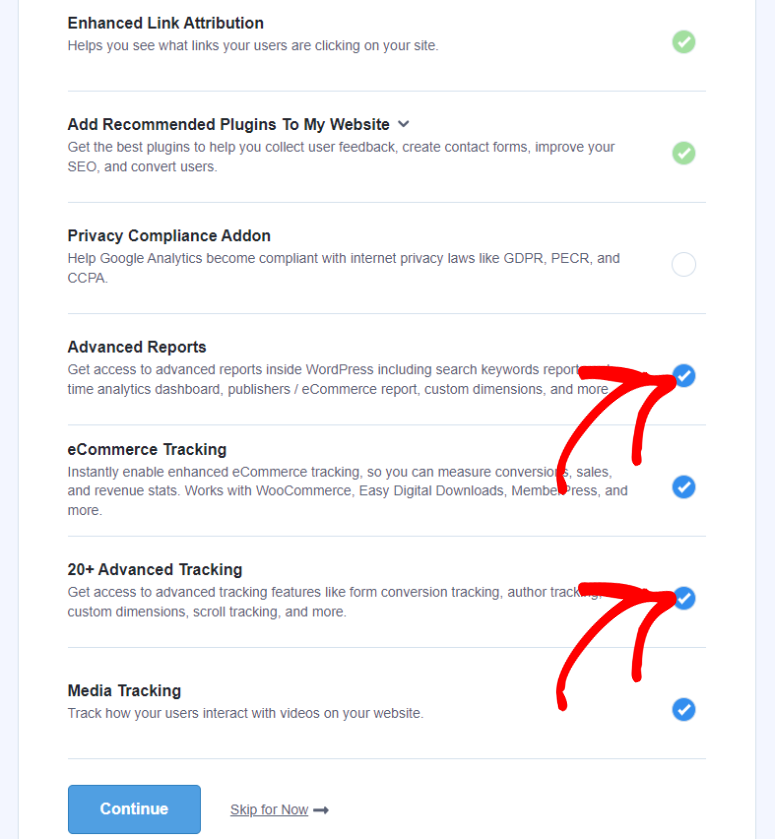
On the last page of the setup wizard, MonsterInsights tells you which configurations were successful and which were not. If you have 20+ Advanced Tracking enabled, MonsterInsights Forms Installed should be marked as a success.
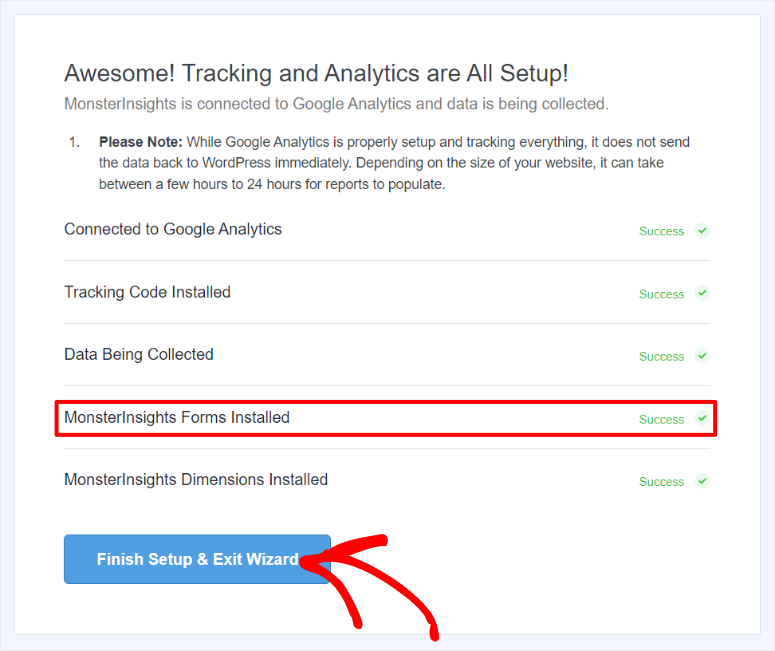
That’s it! You have successfully set up MonsterInsights.
Step 2: Install and set up WPForms
Now, before you can track form submissions and other form metrics, you need a trustworthy form builder plugin.
There are many WordPress form plugins with unique features designed for different users. To get started, you can check out this article about the 18 best form plugins for WordPress.
However, to ensure you find the right form plugin, make sure it is user-friendly, has convenient features, and integrates easily with other tools.
That’s why we decided WPForms!
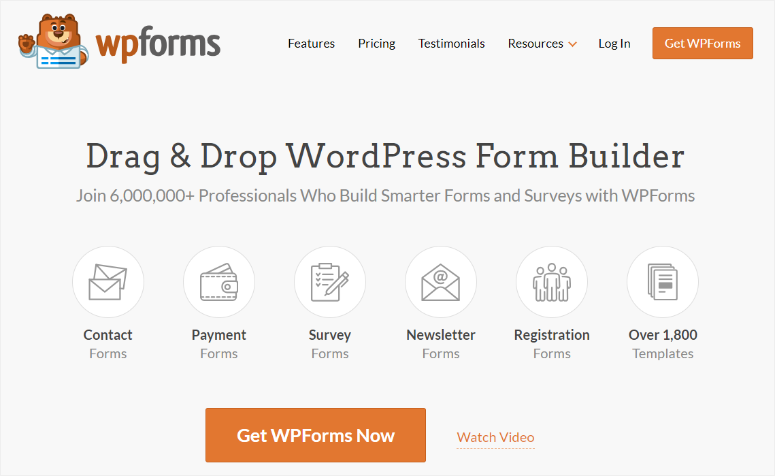
WPForms is the best drag and drop form builder. Thanks to the user-friendly interface, anyone can create forms in minutes without any programming knowledge.
WPForms includes over 1,800 form templates to help you create. You can then further customize each template using the drag-and-drop builder to fit your style and brand.
You can leverage features like conditional logic, anti-spam, and form abandonment tools to ensure smooth and efficient form creation.
WPForms easily integrates with email marketing, CRM tools, and payment gateways. This makes it ideal for beginners and experts who want to improve website functionality and user engagement.
Most importantly, it easily connects to MonsterInsights to enable custom form tracking using Google Analytics 4.
The best thing about WPForms is that just like MonsterInsights, it offers a free and a paid version. You can also easily and quickly connect MonsterInsights to both versions without any programming experience.
Check out the latest WPForms review here to know more about this form builder.
So how do you get started with WPForms?
If you want it WPForms ProVisit the official website and choose a plan. WPForms offers 4 packages to ensure you get one that fits your budget.
If you encounter any problems, check out this tutorial How to set up WPForms Pro.
If you want to use WPForms Litego to your WordPress plugin repository by navigating to Plugin » Add new plugin. Then use the search bar to search for “WPForms” in the repository.
Then install and activate this free plugin like any other plugin. Once WPForms is ready, you can easily start creating any type of form you want.
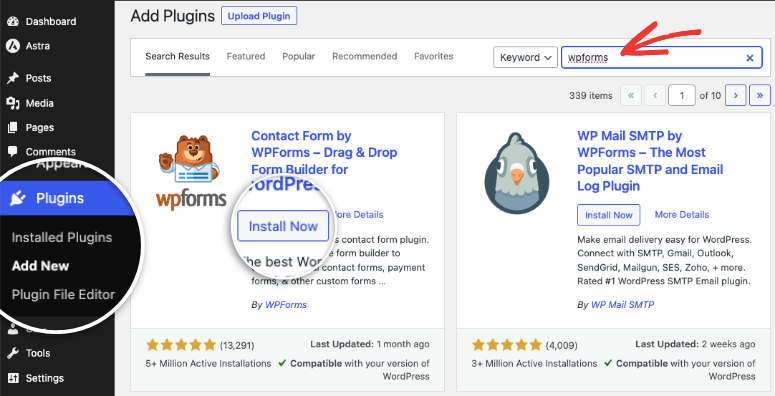
In this article, you’ll learn how to set up your first form with WPForms.
Once you’ve published your forms, you should be able to view your reports after setting up form tracking.
Step 3: Set up MonsterInsights form tracking
At this point, Google Analytics 4, MonsterInsights, and WPForms should be ready to use.
However, to track form data with Monsterinsights and GA4, you need to install an additional MonsterInsights add-on called Forms.
As mentioned above, if you have enabled “20+ Advanced Tracking” using the MonsterInsights Wizard, the MonsterInsights Forms add-on should already be set up.
However, you can also install this form add-on manually.
To do this, go to Insights » Add-ons in your WordPress dashboard and use the search bar to find “Forms”.
Once you find this add-on, install and activate it. And you’re ready to track form data.
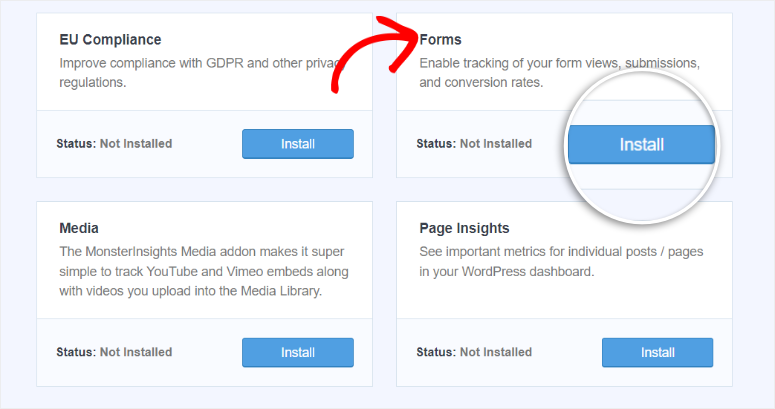
So how do you check your form insights in your WordPress dashboard?
All you have to do is leave Insights » Reports. Here you will see separate tabs with different website analytics such as Overview, Traffic, Search Console, E-Commerce and more.
As already mentioned, you will only be shown the data that you have selected.
Next, select the Forms tab, where you can access information such as form name or ID, impressions, conversions, and conversion rate.
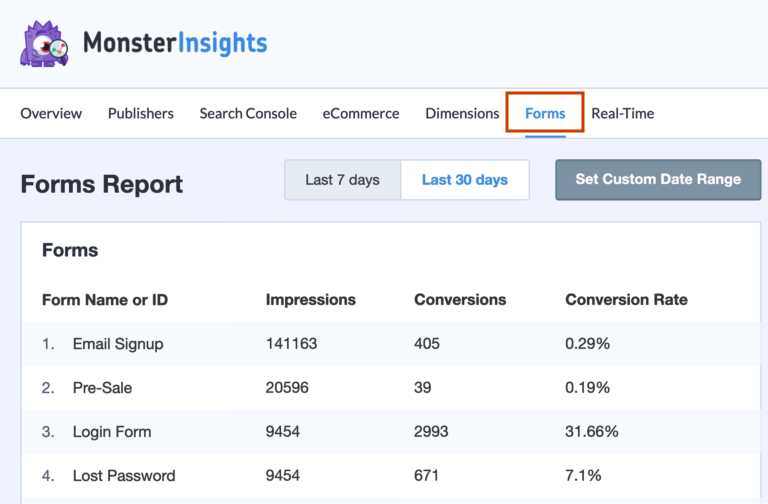
You can define the date range to focus on Today, Yesterday, Last Week, Last Month, Last 7 Days, and Last 30 Days. Additionally, you can set one Custom date range to gain more concrete insights.
If you want to save this data locally to share with your team or clients, you can select “Export PDF Report” with the click of a button.
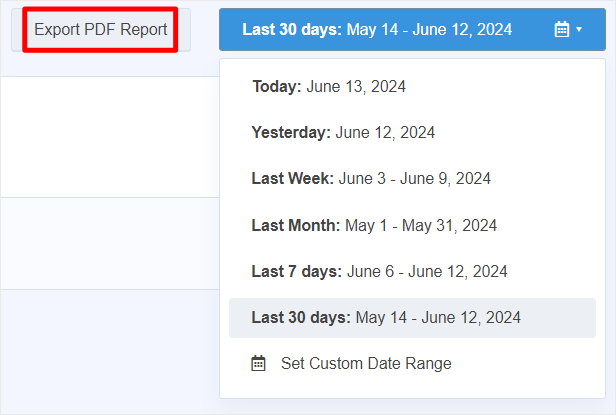
Great! With MonsterInsights you can now track forms from your WordPress dashboard.
Step 4: Set up user journey
While form tracking gives you insight into your website’s numbers, user journey reports allow you to see activity before and after form submission for each user.
It helps you see each user’s navigation path, how they found your form, and what pages they visited afterward.
You can quickly see the fields that your users spent a lot of time on, so you can see what problems they had while filling out your form. The user journey can show you where the user fell off, which can also show you which areas users have the most trouble with.
You can use this information to better optimize your forms for conversion by shortening the form or changing the fields. WPForms also allows you to optimize the form by using conditional logic so that your users only see fields triggered by their response.
In short, user journey reports help you understand user intent and assess lead qualification so you can improve conversions.
So how do you set up the user journey?
To get started, go to WPForms » Add-ons in your WordPress dashboard and search for User Journey add-onthen install and activate.
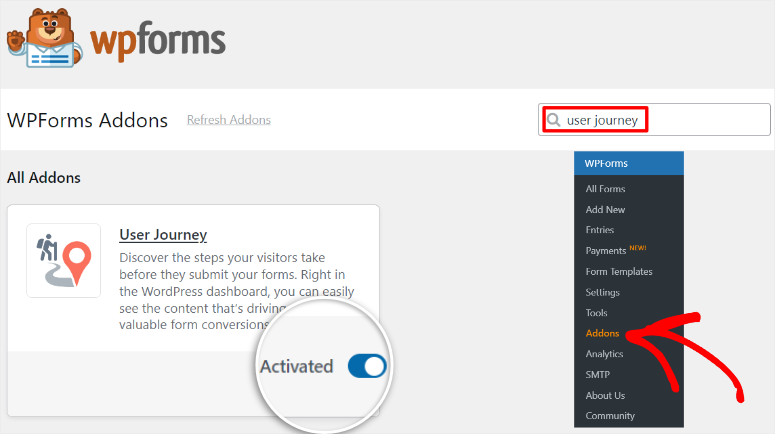
Then to view the user journey reports, go to WPForms » Entrieswhere you can see each user’s name, date of birth, address, date and actions. This gives you a quick overview of each person who has interacted with your forms before drilling down into the user journey.
Next, select “View” and then scroll to the new page until you find it Travel box.

Once you select the Journey field, you’ll see everything the user did with a timestamp, including how long it took to complete that action.
With the WPForms User Journey add-on you can do the following:
- Searched pages and posts before and after submitting the form
- The search they performed to land on your website
- Identify the URL that takes you to the website
- The UTM tags for the campaign
- Time spent on your website
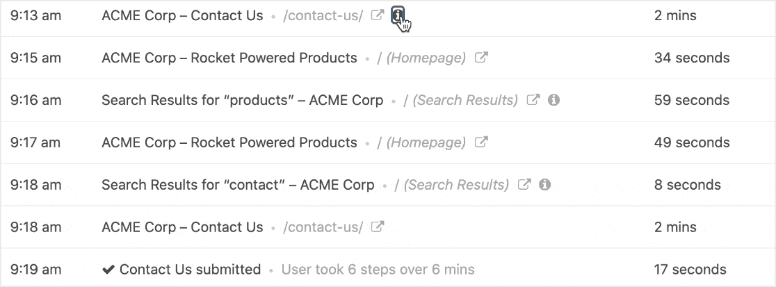
Optional Bonus Step: Advanced Form Tracking in Google Analytics 4
As mentioned, MonsterInsights simplifies the GA-4 data so that it is easy to understand and follow. If you want to review advanced or raw form data, you can set up and view it in Google Analytics 4.
However, if you want to skip this step, don’t worry. The WPForms User Journey add-on provides similar data and form metrics right in your WordPress. You can use it without worrying about missing important data.
So how do you set up advanced custom form tracking in your GA4 account?
First, log in to your Google Analytics dashboard and select the Explore Tab. Here, select the “Blank” report option to create a new custom report.

Then click the plus sign (+) next to “Dimensions” and search for the following dimensions.
- Session source/medium
- Page path + query string
- New/established
- Event name
- Form ID
Once you find a dimension, add it by checking the check boxes next to each dimension. Once you have selected all dimensions, click the Import button to add them to your report.
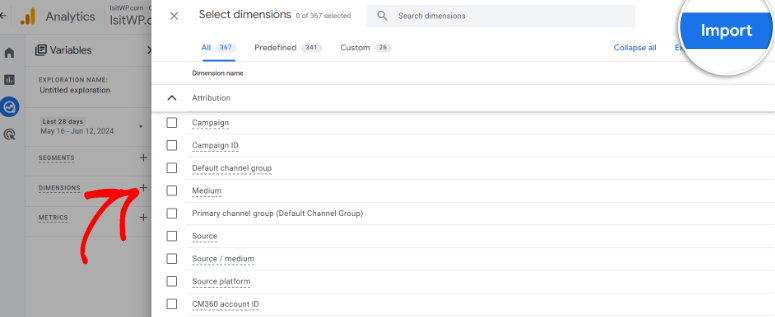
Next, add the metrics you need to measure the amount of data by selecting the plus sign (+) next to it Metrics.
To do this, search for “Event Count” and add it Metrics to measure how often the user triggers a GA4 event, such as submitting a form.

Now that you have all the dimensions and metrics you need, it’s time to create your report.
To do this, drag and drop “Form ID” and “Session Source/Media” from the “Dimensions” field into the rows Crate.
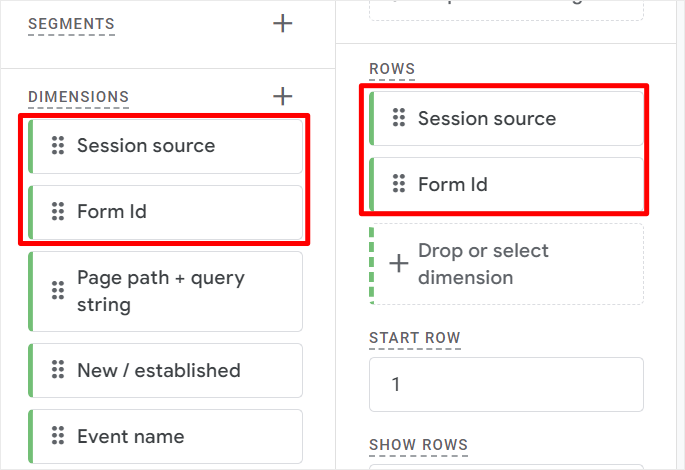
Then drag and drop “Event Count”. Metrics for the Values Crate.
At this point you should notice that your report is populated with data. However, since it includes all website events and custom events, we need to narrow it down to show form submissions.
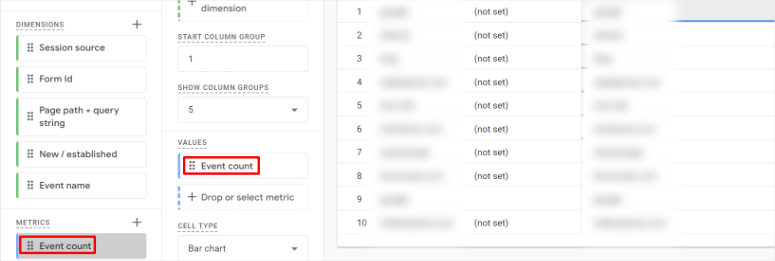
To do this, add a filter using drag and drop “event name” from the “Dimensions” field to “Filters”.
Then select “Exact Match” from the “Filter” drop-down menu. Then enter “generate_lead” in the field below.
Once this is done, press Apply.
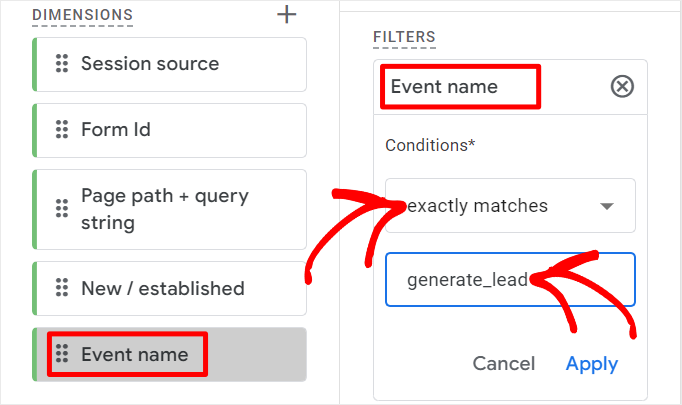
Congratulations! You can now set up form tracking with MonsterInsights and Google Analytics 4. If you have any further questions, check out our FAQs below.
FAQs: How to set up WordPress form tracking in Google Analytics
How is form abandonment tracking done?
Use the WPForms Form Abandonment add-on to easily track this metric. This add-on allows you to capture partial input from users who start filling out a form but do not complete it. You can also use MonsterInsights to automatically track form abandonments directly in your WordPress dashboard. The other option is to create a custom report using Google Analytics 4.
Is MonsterInsights free?
Yes, MonsterInsights offers both free and premium versions. The free version, MonsterInsights Lite, offers basic Google Analytics integration and key tracking features. However, for advanced tracking features like form tracking, you need the Pro plan or higher. The premium plans also offer additional features such as advanced eCommerce tracking, affiliate link tracking, and detailed reports.
Can I track form submissions without a plugin?
In any case, you can track form submissions without a plugin by manually adding tracking code to your WordPress site. This includes using Google Tag Manager to set up triggers and tags for form submissions. You must add specific JavaScript code to your form elements to capture submission events. Although this method offers flexibility, it requires programming knowledge and can be time-consuming. For a simpler solution, using a plugin like MonsterInsights simplifies the process and requires no coding knowledge.
Can WPForms save form data?
Yes, WPForms can save form data. When users submit a form created with WPForms, the data is stored in the WordPress database. You can view and manage these entries in the WordPress dashboard by navigating to WPForms » Entries. This feature is available in both the free and premium versions of WPForms. Additionally, WPForms integrates with various email marketing and CRM tools. This allows you to automatically send form data to your preferred platforms for further processing and tracking.
That’s it! We hope you enjoyed reading this step-by-step guide on setting up form tracking in WordPress. If you want to know what’s new in GA4, check out this article on Google Analytics 4 vs. Universal Analytics: Complete Comparison.
Additionally, here are other articles you may want to read.
In the first article you will learn how to set up conversion tracking in WordPress. The next post lists the 7 best WordPress Google Analytics alternatives. In the last article you will learn how to track and monitor user activity in WordPress.
